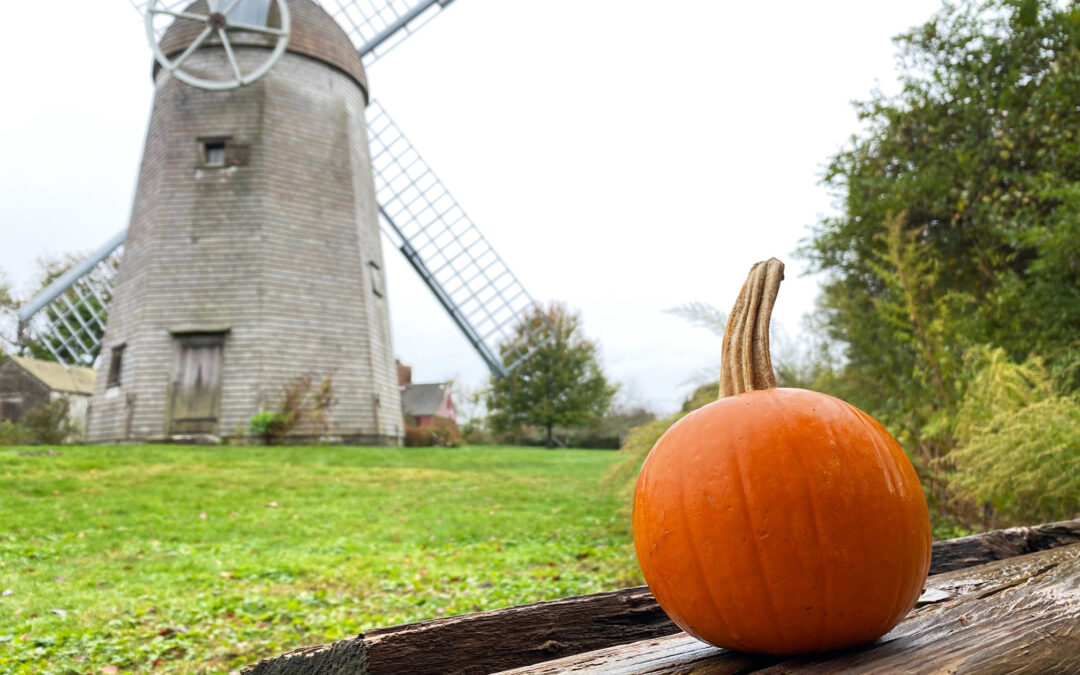
by NRF User | Oct 29, 2020 | NRF News
For years now, NRF has been fortunate to partner with the University of Rhode Island Master Gardener program to assist in the care, interpretation, and programming of three gardens at Prescott Farm—an 18th-century vegetable garden, herb garden, and a three-sisters garden that attempts to replicate the growing practices of the Narragansett peoples who have called Aquidneck Island home for millennia. The Master Gardeners are all volunteers who train through the University of Rhode Island and volunteer their time to work on projects throughout the state. Typically, the Master Gardeners have donated all of their produce to Lucy’s Hearth, an organization dedicated to helping families experiencing homelessness. In 2020, the Master Gardeners continued that tradition but did even more.
Early in the year, our Director of Museums, Dr. Erik Greenberg, met with Susan Estabrook, who has overseen the Master Gardeners’ program at Prescott Farm for years, and asked if they could grow a pumpkin patch which NRF could then donate to the children at Newport’s Martin Luther King, Jr. Community Center (MLK) in time for Halloween. Dr. Greenberg has dedicated much of his career to community outreach, and he has been working with the MLK Center to figure out ways in which the museums of NRF can be a resource to their staff and to the people who make use of the center on a regular basis. As always, Susan and her team threw themselves into the work with expertise and passion, growing enough pumpkins to donate to the center with more to spare.
“It was important to me to make sure the pumpkins we grew were all good eating pumpkins so that the kids could learn they are not just decorations but actually a great food source,” said Estabrook. “As we know, the seeds and the flesh are nutritious and can be eaten when prepared in a sweet or savory way.”
The gardeners decided to grow three different varieties of pumpkins. “Baby Pam” and “Small Sugar Pie” pumpkins, which are both small round varieties recommended for eating, were grown for the MLK Center. The third variety, “New England Long Pie Pumpkin,” which looks like an overgrown zucchini squash but orange in color, were grown to be donated to Lucy’s Hearth.
At Prescott Farm, the Master Gardeners chose a plot of land to grow pumpkins that was located to the east of the windmill, which was a prime spot full of sun and had never been used for growing crops before. They marked out the plot and covered it with cardboard, paper, and leaves. One of the volunteer gardeners brought in two dump trucks full of bagged leaves. After leaving the leaves and paper on for some time, they chopped the leaves and then covered them with compost. They then planted through it, never having to till the soil. The plants were started at Estabrook’s home first, then transferred to the farm and covered with row cover to protect them from critters and give them a boost of warmth. One devoted volunteer was in charge of watering, and once the plants got to the point of needing pollinators, they were uncovered and left to do their thing!
Many visitors to Prescott Farm watched the pumpkins grow and came back to see them when they were ripe. “It was a great learning experience for all and a good draw to the property for the local families,” said Estabrook. “We grew over two hundred pumpkins that amounted to over 500lbs.”
The pumpkins were delivered to the MLK Community Center on October 26th to be used in their education programs (preschool and after school) to not only decorate, but to explore. The Center’s preschool participates in “Pumpkin Science” as part of their STEM curriculum where students have the opportunity to explore parts of a pumpkin, measure the size and shape, feel the fibrous insides, and make nutritious roasted pumpkin seeds.
The students pictured are from the MLK Community Center’s preschool classrooms where they enjoyed working with their pumpkins the entire week. They did pumpkin experiments: Will they float or sink in water? How tall is it? They made scientific observations, learned about what’s inside both pumpkins and squash, and what happens outside as Autumn approaches.
Dr. Greenberg hopes that this is the first in a series of community-based projects that demonstrates NRF’s commitment to the people of Aquidneck Island, and he (as well as the entire staff at NRF) are deeply grateful for our longstanding partnership with the Master Gardeners. Thank you to all of the organizations involved in making this project possible.
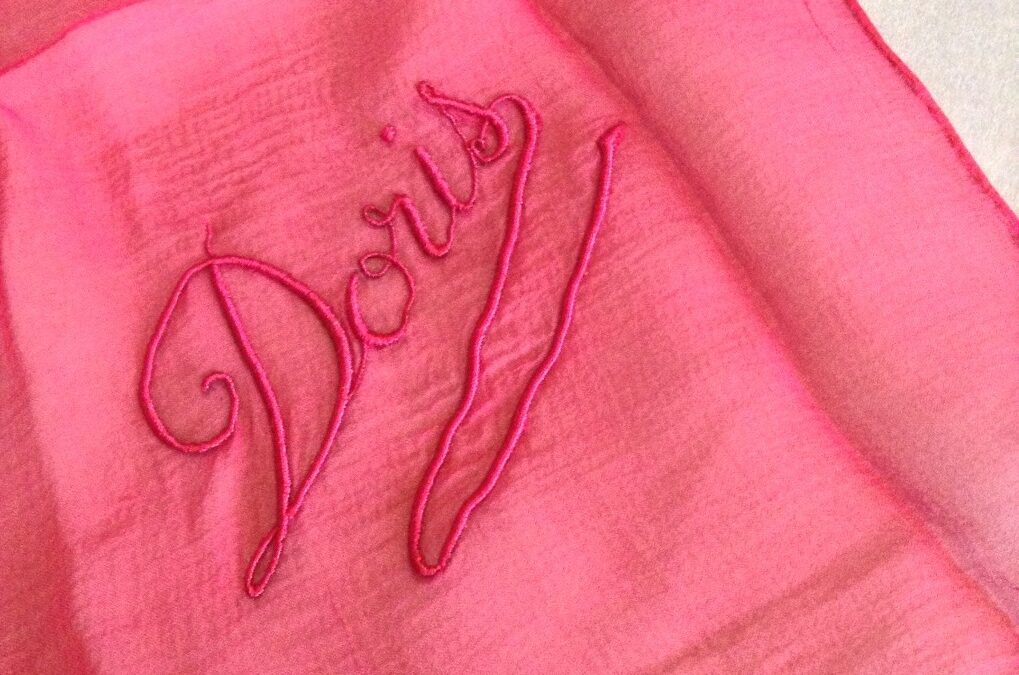
by NRF User | Oct 14, 2020 | NRF News
Despite being a native of Rhode Island, Doris Duke was a stranger to me prior to my summer internship in collections at Rough Point. Over the weeks, I made Duke’s acquaintance in the most personal of ways: through an examination of her clothing. Each day, I climbed three flights of stairs to what had been the servants’ quarters to my solitary workroom. There I opened box after box of a donation of her personal wardrobe from Shangri La, Duke’s Hawaiian estate. I carefully documented the contents by examining each object, assessing its potential provenance and condition, and then repacking it. With the sense of time travel that objects of the past imbue, I became a steward of Doris Duke’s personal belongings, like the servants who had occupied this space before.
I traveled through time and space with Doris, via her clothing, in a distinctly non-linear fashion; from the 1960s in Mumbai, possibly back to the 1930s in North Africa, and then forward again to the late 1970s in New York City. Clothing, especially for the fashion-conscious like Doris, is an unmistakable expression of self-identity. Each garment and accessory is chosen purposefully, to reveal or to conceal the body, to impress others, or to express support for a cause. Some items were souvenirs from her far-flung travels, a way to commemorate a place and time, while others, clearly handmade and without labels, were probably commissioned from a local seamstress. The haute couture and designer pieces clue one in to the social circles Doris might have circulated in, and when she may have been abroad on a shopping trip. Duplicates of one item, bought in different colorways, can indicate what colors she preferred based on which garment has the most evidence of wear.
Few other museums, if any, are fortunate enough to have most of a singular person’s wardrobe, and therefore to be able to interpret their lives in this way. The Western European concept of the fashion exhibit, especially of contemporary clothing, developed in the late 20th century. People did not purchase their clothes with the anticipation that these garments, sometimes including their undergarments, would eventually be on display in a museum, and used to document and interpret the history of their lives.
Two months is a short time to try to get to know someone – even though I had over 730 “opportunities” (the number of objects I documented) to do so. I was left with many questions– I will elaborate on just one here. Duke’s sense of style seems to have flourished in the 1960s and 1970s, and subsequently so do the number of pieces from that period in the collection, whereas the dearth of midcentury garments compounds the mystery of her life at that time. A rare, haute couture, green velvet Dior coatdress with leopard cuffs from 1947 was one exception. The design of this piece clearly fits with Duke’s style markers of dazzling jewel-tone colors, metallic trimmings, and foreign inspiration (according to the designer history, it was supposedly inspired by Russia).
In contrast, some of her other pieces from the post-war, New Look-era are a filmy, off-white, strapless bouffant gown and a beige hostess gown (a robe-like garment sufficiently elegant enough for entertaining guests) in a floral-patterned ikat taffeta. These are both beautiful, but not visually striking. The wearer could easily fade into the background. Why might Doris, typically a bold dresser, have chosen to own and wear them?
The obvious question, for today’s readers, however, is “what to wear in lockdown?” Here, Duke’s answer is easy to imagine…the house dress is the perfect balance of comfort and fashion when one must hide away from the world.
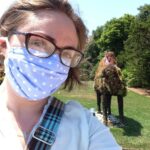
By Alyssa C. Opishinski
Summer 2020 Collections Intern and URI graduate student studying Fashion History and Textile Science in the Dept. of Textiles, Merchandising, and Design. More about Alyssa’s summer internship can be found on Instagram: @thesartorialsleuth and #dukesdailypattern
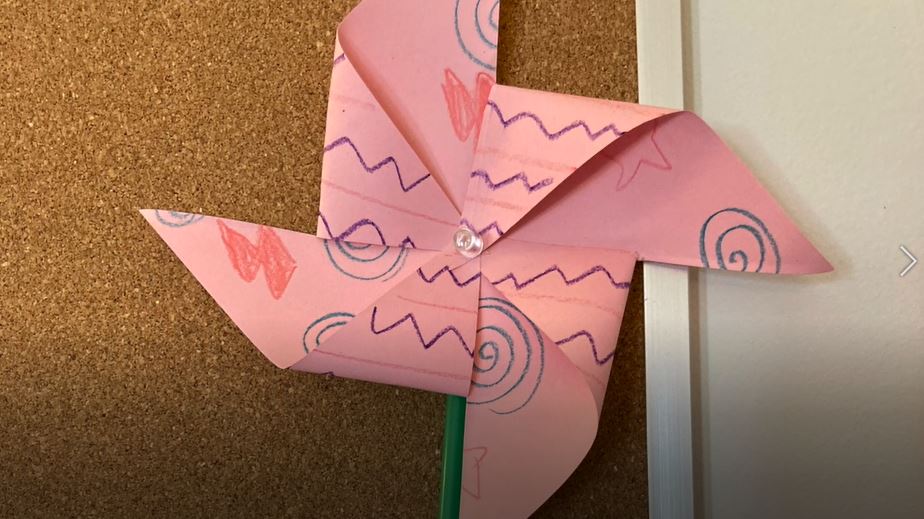
by NRF User | Oct 7, 2020 | NRF News
Click here to watch October’s Second Sunday From Home program where we join the crew of Oliver Hazard Perry Rhode Island to learn more about wind and sails. See below for instructions on how to make a pinwheel that catches the wind like sails do!
Making a pinwheel:
Supplies
- Paper (cut into 6”x6” size)
- Scissors
- Straw
- Push pin or brass fastener
- Crayons/markers/colored pencils/etc.
Instructions
- Decorate both sides of your paper however you would like!
- Fold your paper in half to make a triangle, then unfold.
- Fold your paper in the opposite direction to make a triangle, then unfold. There should be two creases in the paper, forming an X in the middle
- Cut a 3” slit from each corner toward the center
- Fold one corner in towards the center and rotate counter clockwise, folding the corner of each towards the center, so that they overlap.
- Hold in place and insert a brass fastener or push pin through the center
- Place fastener through the top of the straw. If needed, place tape on the back of the push pin.
- Blow pinwheel and watch it spin!
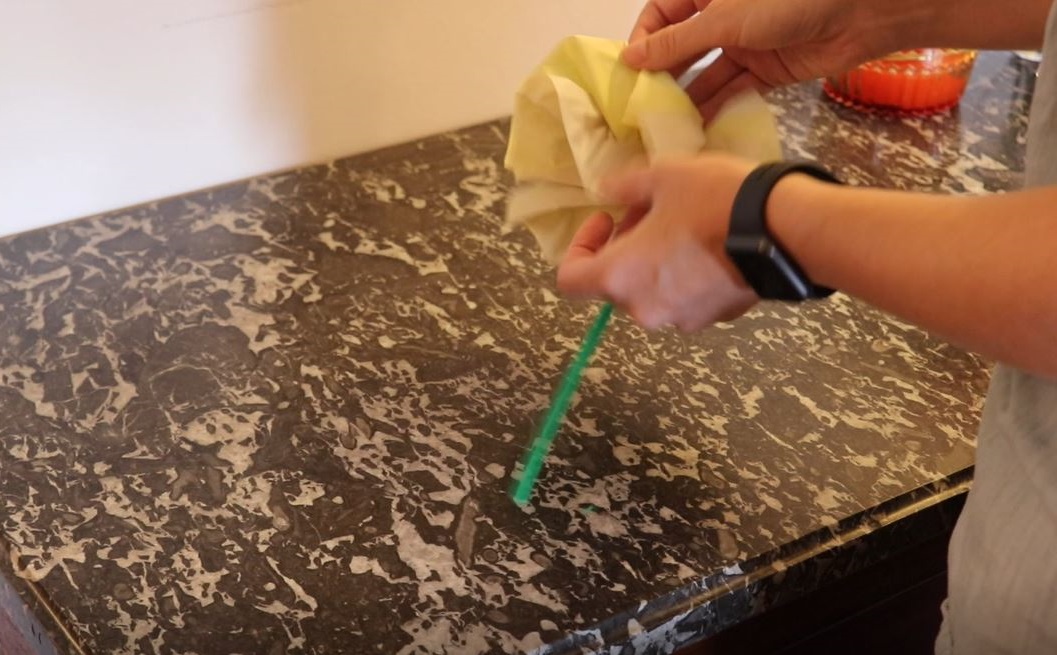
by NRF User | Sep 10, 2020 | NRF News
Click here to watch September’s Second Sunday From Home program where we join Aquidneck Community Table to learn more about growing a community garden. See below for instructions on how to make your own flowers that you can keep forever!
Materials:
- Tissue paper
- Scissors
- Pipe cleaner
- Depending what size flowers you would like, cut the tissue paper into equal pieces. Generally, 12×6” size paper works well for medium-sized flowers.
- Take three pieces of tissue paper (can be all the same color, different colors, whatever suits you!) and place them on top of each other in the same direction. Fold the tissue paper like an accordion—first, make a 1” fold along the short edge, then flip it over and make a 1” fold going in the reverse direction, until the whole sheet has been folded like an accordion.
- Place your pipe cleaner in the center of the tissue paper (centered on the long edge), and loop it around the tissue paper, twisting to ensure it stays in place. This is your stem!
- Gently open up the tissue paper folds you made, and separate the tissue paper sheets to make your flower bloom. This can be tricky, so it’s important to be very gentle when pulling apart the sheets.
Share your flowers with us on social media by tagging us @nptrestoration.
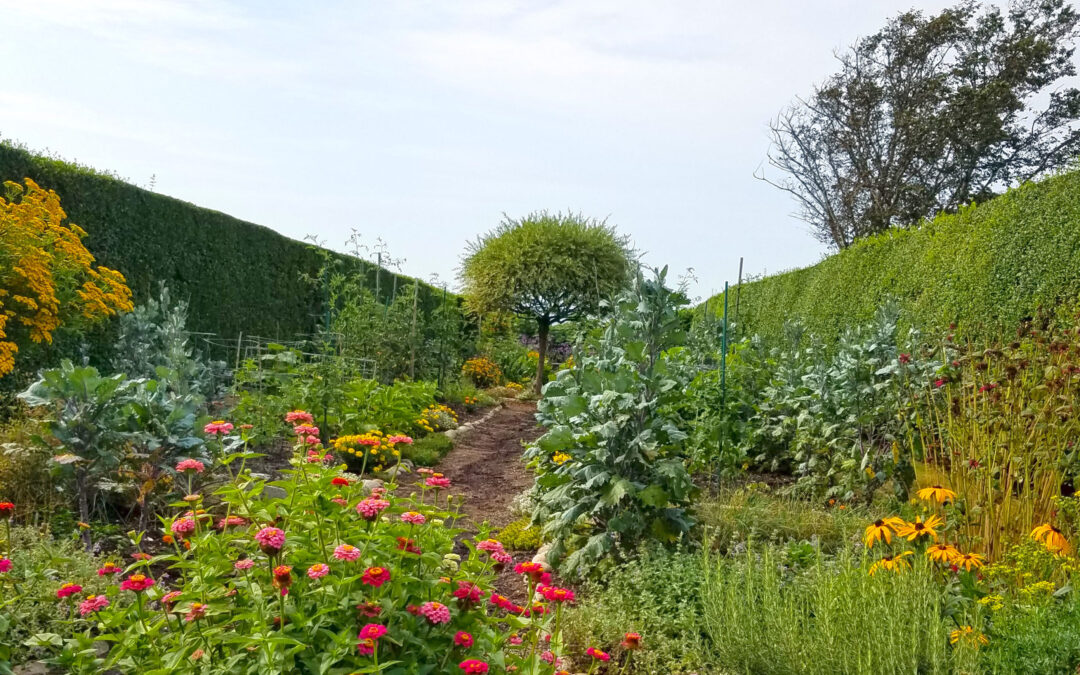
by NRF User | Aug 18, 2020 | NRF News
The cicadas call from the trees, the gardens have slowed down their growth, and the air has become thick and still: we have entered into the dog days of summer. I recall gazing at the winter landscapes with anticipation for the spring, dreaming of colors and flowers as if winter would never end. Now I am standing in the shade of a tree as the summer sun wraps itself around everything in a fiery attempt to forget its daily diminishing, as if to say, “I am not ready for fall.”
This past season has flown by, and although there are still a couple more months left to the growing year I can’t help but to begin to reflect on this past season. The most wonderful part of being an estate gardener is being able to witness the ever changing landscape while being a part of the process for that change to occur. At the beginning of my season, I cleaned the gardens, preparing them for a new year by cutting last year’s plants to the ground to make room for this year’s growth, and adding compost to garden beds. I started vegetable seedlings and dahlia tubers inside for spring planting and began to plan for the upcoming season. Slowly as the winter turned to spring, I watched as buds emerged on trees, and perennials pushed their way up through the cold soil. The vegetable seedlings I started finally became large enough to move into bigger pots, and dahlias began to send out their first growth from their tubers. The first signs of the returning of spring evoke such joy, and although the winter holds its own beauty, spring whispers for the world to wake up.
Finally, once forecasts for over-night frosts disappeared from the monthly weather report, it became time to plant the gardens. Planting is very much like painting- each plant being its own color of paint, and the gardener arranging the plants as if choosing from paints on a palette. Planting a garden takes quite a bit of foresight. Knowing how plants perform next to each other (companion planting), what colors the plant’s foliage, flowers, and fall appearance may be, the height and width of the plants at full growth… all of these factors come into play while planning a garden. This year we took these factors into account while redesigning and replanting the East Garden, the Dahlia Beds, and the Kitchen Garden. Plants were chosen and placed where they would hold value next to another plant, whether that be through color contrast, size differences, or beneficial plant growth/health aspects.
The kitchen garden is a wonderful example of how gardens can evolve throughout the season. From the beginning of the year to the end of the season it goes through many appearance changes that take into account the factors that were mentioned above. In the late spring the garden is lush with low growing, cold weather plants: cabbage, lettuce, radish, kale, onion, and chard. Planted amidst these food crops are flowers such as marigolds, alyssum, and perennial flowers just beginning to push their foliage up from underground. As the weather begins to warm up the cabbages, lettuce and radishes are harvested from the gardens and replaced with beans, squash, cucumbers, tomatoes, peppers, eggplant, and basil. These summer vegetables are planted thoughtfully, the cucumbers and pole beans are grown on trellises to save space, the tomatoes are caged and staked upwards to give height to the garden and then under planted with zinnias, verbena bonariensis, basil, and bush beans to fill in the middle ground, and the zucchini and summer squash crawl across the ground.
As the summer wears on and the gardens slow down, I will begin to pull out zucchini and cucumber vines, slowly the tomatoes will stop producing fruit, the beans will stop producing beans. But as these summer vegetables come to the end of their season I am planting seeds for the fall: beets, turnips, lettuces, parsley. Even after the height of the season passes there is still another transition in the garden to look forward to before the gardens lay barren again in the winter.
As the summer flowers in the perennial gardens begin to fade the dahlias are growing and putting on buds for a beautiful fall display. Some flowers that bloomed in the middle of the summer are waiting to bloom once more once the weather gets cooler. The Caryopteris in the Tropical garden will bloom, sending out beautiful blue flowers, and ornamental grasses will show off with their seed heads nodding in the cool fall breeze.
The dog days of summer are often thought about in an almost wistful way. It is a time of change and nostalgia. It is a time where we are all remembering the feeling of sadness we had as children realizing it was nearing time to go back to school, realizing that the careless fun of summer is coming to an end. But the dog days of summer are not an end. The dog days of summer are a reminder that at the plateau of summer when things seem to sleep an exhausted sleep in the hot sun, that it is only a time for stillness in order to recharge and jump into fall with renewed energy. We will see this all around us in the fall leaves and the regrowth and changes in the plants in our landscapes.
Once again, the winter will come and the land will hibernate until spring. Until then, let’s take advantage of the beauty that surrounds us, in public gardens such as ours at Rough Point, in our own yards, and even in the trees and plants that line the sides of the streets in our travels.
By Tessa Young, Estate Gardener at Newport Restoration Foundation

by NRF User | Jul 27, 2020 | NRF News
Click here to watch August’s Second Sunday From Home program where we join Clean Ocean Access to learn more about recycling here in Newport. See below for instructions on how to make a book out of recycled materials to celebrate National Book Lovers’ Day on August 9!
Supplies:
- Thin cardboard (such as a cereal box)
- Blank paper, or scrap paper
- Rubber bands
- Ruler
- Scissors
- Crayons (to decorate)
Directions
- Cut cardboard to the desired size of the book (remember that it should be the width of both the front and the back!).
- Fold the cover in half.
- Using the ruler, measure your blank paper to the size of the cover you have just cut out, making sure that it is either the same size or smaller.
- Fold the paper in half. About 5-8 sheets at a time generally works best for folding.
- Align the paper with the cover and slip a rubber band around the center, running along the center crease, to attach the paper to the cover.
- Repeat steps 3-5 to create more pages in your book if you would like. Each additional “packet” of paper should go behind the one before it, and affixed with its own rubber band running along the center crease.
- Once you have attached all your paper, you can use your scraps or other craft supplies found around your house to decorate your cover!
- Then, grab a pencil and start writing!







